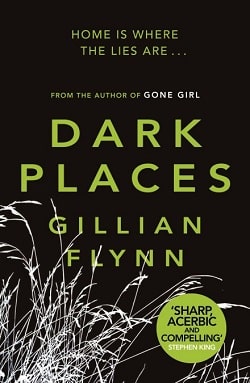Summary

Dark Places
by Gillian Flynn
Libby Day was seven when her mother and two sisters were murdered in “The Satan Sacrifice of Kinnakee, Kansas.” She survived—and famously testified that her fifteen-year-old brother, Ben, was the killer. Twenty-five years later, the Kill Club—a secret society obsessed with notorious crimes—locates Libby and pumps her for details. They hope to discover proof that may free Ben.
Libby hopes to turn a profit off her tragic history: She’ll reconnect with the players from that night and report her findings to the club—for a fee. As Libby’s search takes her from shabby Missouri strip clubs to abandoned Oklahoma tourist towns, the unimaginable truth emerges, and Libby finds herself right back where she started—on the run from a killer.
.
Read
Dark Places on http://kissnovel.net
Martial Peak Reviews
Dark Places by Gillian Flynn is a gripping psychological thriller that delves into the darkest corners of human nature, trauma, and the quest for truth. With its intricate plot and deeply flawed characters, Flynn crafts a narrative that is both unsettling and compelling, keeping readers on the edge of their seats from start to finish.
The story revolves around Libby Day, who, at the tender age of seven, witnessed the brutal murder of her mother and two sisters in what became known as “The Satan Sacrifice of Kinnakee, Kansas.” Libby’s testimony led to the conviction of her older brother, Ben, who has spent the last twenty-five years in prison. Now an adult, Libby is haunted by her past, struggling with the weight of her trauma and the public's perception of her as the sole survivor of a horrific crime.
One of the most striking themes in Dark Places is the exploration of memory and its reliability. Libby’s recollections of that fateful night are fragmented and clouded by the trauma she endured. As she embarks on a journey to reconnect with the people involved in her family’s murder, the reader is drawn into a labyrinth of conflicting narratives. Flynn masterfully plays with the idea that memory can be both a refuge and a prison, as Libby grapples with her own version of events and the possibility that she may have been wrong about her brother’s guilt.
Character development is another area where Flynn excels. Libby is a complex protagonist, embodying both vulnerability and resilience. Her initial motivation to profit from her tragic past reveals a deep-seated need for control in a life that has been dictated by others. As she interacts with members of the Kill Club—an obsessive group dedicated to solving infamous crimes—Libby’s character evolves. She transforms from a passive survivor into an active seeker of truth, albeit one who is often reckless and self-destructive. This evolution is both compelling and relatable, as readers witness her struggle to reclaim her narrative.
In contrast, the supporting characters are equally well-drawn, each adding layers to the story. Ben, though largely absent from the present timeline, looms large over Libby’s life. His character is explored through flashbacks and the perspectives of others, creating a sense of ambiguity that keeps readers questioning his innocence. The members of the Kill Club, particularly the enigmatic Lyle and the obsessive Deanna, serve as mirrors to Libby’s own obsession with her past, highlighting the fine line between seeking justice and indulging in morbid curiosity.
The setting of the novel plays a crucial role in enhancing its themes. Flynn paints a vivid picture of small-town America, with its dilapidated buildings and forgotten histories. The contrast between the mundane and the horrific amplifies the sense of dread that permeates the narrative. As Libby travels through Missouri and Oklahoma, the decaying landscapes serve as a backdrop for her internal journey, reflecting her own sense of decay and disillusionment.
Flynn’s writing style is sharp and evocative, characterized by a keen attention to detail and a knack for creating tension. The alternating timelines—one following Libby in the present and the other revealing the events of the night of the murders—keep readers engaged and guessing. Flynn expertly weaves together the threads of the past and present, culminating in a shocking revelation that forces both Libby and the reader to confront uncomfortable truths.
Moreover, Dark Places raises important questions about the nature of evil and the impact of trauma on individuals and families. Flynn does not shy away from depicting the brutality of violence, but she also explores the psychological ramifications that linger long after the physical act has occurred. Libby’s journey is not just about uncovering the truth behind her family’s murder; it is also about understanding herself and the choices she has made in the aftermath of that night.
In comparison to Flynn’s other works, such as Gone Girl, Dark Places offers a more raw and visceral exploration of trauma. While Gone Girl delves into the complexities of marriage and deceit, Dark Places focuses on the aftermath of violence and the quest for redemption. Both novels showcase Flynn’s talent for creating morally ambiguous characters, but Dark Places stands out for its unflinching portrayal of the psychological scars left by tragedy.
Overall, Dark Places is a haunting and thought-provoking read that lingers long after the final page is turned. Flynn’s ability to intertwine suspense with deep psychological insight makes this novel a standout in the genre. It challenges readers to confront their own perceptions of truth and justice, leaving them questioning the very nature of evil. For those who appreciate a dark, intricately woven narrative that explores the complexities of the human psyche, Dark Places is an essential addition to their reading list.
For more information, you can find the book on Goodreads.
























Reviews 0
Post a Reviews: